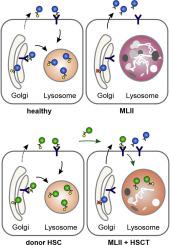Molecular Genetics and Metabolism Reports ( IF 1.8 ) Pub Date : 2021-01-14 , DOI: 10.1016/j.ymgmr.2020.100704 Luise Sophie Ammer 1, 2 , Sandra Pohl 2, 3 , Sandra Rafaela Breyer 2, 4, 5 , Charlotte Aries 1, 2 , Jonas Denecke 1 , Anna Perez 1, 2 , Martin Petzoldt 6 , Johanna Schrum 7 , Ingo Müller 7 , Nicole Maria Muschol 1, 2

|
Background
Mucolipidosis type II (MLII) is an ultra-rare lysosomal storage disorder caused by defective lysosomal enzyme trafficking. Clinical hallmarks are craniofacial dysmorphia, cardiorespiratory dysfunction, hepatosplenomegaly, skeletal deformities and neurocognitive retardation. Death usually occurs in the first decade of life and no cure exists. Hematopoietic stem cell transplantation (HSCT) has been performed in few MLII patients, but comprehensive follow-up data are extremely scarce.
Methods
MLII diagnosis was confirmed in a female three-month-old patient with the mutations c.2213C > A and c.2220_2221dup in the GNPTAB gene. At nine months of age, the patient received HSCT from a 9/10 human leukocyte antigen (HLA)-matched unrelated donor.
Results
HSCT resulted in a sustained reduction of lysosomal storage und bone metabolism markers. At six years of age, the patient showed normal cardiac function, partial respiratory insufficiency and moderate hepatomegaly, whereas skeletal manifestations had progressed. However, the patient could walk and maintained an overall good quality of life. Neurocognitive testing revealed a developmental quotient of 36%. The patient died at 6.6 years of age following a human metapneumovirus (hMPV) pneumonia.
Conclusions
The exact benefit remains unclear as current literature vastly lacks comparable data on MLII natural history patients. In order to evaluate experimental therapies, in-depth prospective studies and registries of untreated MLII patients are indispensable.
中文翻译:

造血干细胞移植是 II 型粘脂沉积症的治疗选择吗?
背景
II 型粘脂沉积症 (MLII) 是一种极其罕见的溶酶体贮积症,由溶酶体酶运输缺陷引起。临床特征是颅面畸形、心肺功能障碍、肝脾肿大、骨骼畸形和神经认知迟缓。死亡通常发生在生命的最初十年,并且没有治愈方法。造血干细胞移植(HSCT)已在少数MLII患者中进行,但全面的随访数据极其缺乏。
方法
一名 3 个月大的女性患者确诊为 MLII,其GNPTAB基因突变为 c.2213C > A 和 c.2220_2221dup。9 个月大时,患者接受了来自 9/10 人类白细胞抗原 (HLA) 匹配的无关供体的 HSCT。
结果
HSCT 导致溶酶体储存和骨代谢标志物持续减少。六岁时,患者表现出正常的心功能、部分呼吸功能不全和中度肝脏肿大,而骨骼表现却有所进展。然而,患者可以行走并保持总体良好的生活质量。神经认知测试显示发育商数为 36%。该患者死于人类偏肺病毒 (hMPV) 肺炎,年仅 6.6 岁。
结论
确切的益处仍不清楚,因为目前的文献极大缺乏 MLII 自然史患者的可比数据。为了评估实验性疗法,深入的前瞻性研究和未经治疗的 MLII 患者的登记是必不可少的。











































 京公网安备 11010802027423号
京公网安备 11010802027423号